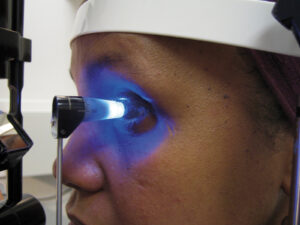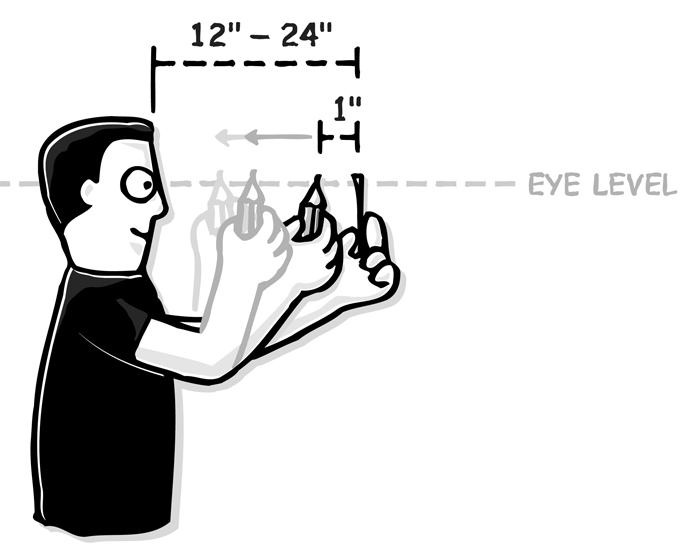
What Is Normal Eye Pressure?
Eye health involves more than just clear vision or 20/20 eyesight. One crucial but often overlooked measurement is eye pressure – also known as intraocular pressure (IOP). So, what is normal eye pressure, and why does it matter for your long-term vision health?
Before we get into those specifics, let’s talk a little more about what eye pressure is. First, as the name suggests, intraocular pressure measures the fluid pressure inside the eye. In order to maintain good vision health, your eyes need to both produce and drain fluid at the correct rate. This helps to maintain eye shape and properly nourish the eye’s internal structures. As you may imagine, both high and low intraocular pressure can signal underlying health issues. In this article, we’ll discuss what normal eye pressure is, how it’s measured, and how to manage it to ensure you maintain healthy vision for as long as possible.
What Is Normal?
Doctors measure eye pressure in millimeters of mercury, or mmHg. This is because, historically, measurements for things like the weather and blood pressure were made using devices like barometers, which showed readable measurements using mercury rising or falling in a glass column.

These days, the gold standard for measuring eye pressure is using the Goldmann applanation tonometry. This device looks at the shape of the cornea to determine eye pressure. However, doctors more commonly measure it using air puff tonometry. So, if you ever wondered why your eye doctor is shooting a puff of air into your eye during your annual check-up, now you know!
The scientifically accepted normal eye pressure range for adults is 10-21 mmHg. However, if you get your eye pressure measured at your next eye appointment and it falls outside that range, don’t worry just yet. High or low intraocular pressure doesn’t always mean disease outright, but it does increase your risk of developing diseases like glaucoma or retinal issues. Talk to your eye doctor about your results and take their advice – there is a lot you can do to prevent disease from progressing if your measurements are a little high or low.
What Causes High or Low Eye Pressure?
Before we talk about what to do if your measurements fall outside that range, let’s back up for a moment and talk about the causes. There are many different factors that impact intraocular pressure. Both high and low intraocular pressure can be signs that something is wrong with your eyes. High intraocular pressure, or ocular hypertension, is often caused by the overproduction of fluid or poor drainage in the eye. It can also be caused by medication side effects or trauma.
So, how does the eye normally deal with fluids? Between the cornea (clear front layer of the eye) and the iris (colored part of the eye), there’s a space called the anterior chamber. Fluid normally flows through this space and out of an opening where the iris and cornea meet. The opening has spongy tissue in it, called the trabecular meshwork, through which fluid can normally pass. However, sometimes the trabecular meshwork blocks the fluid from draining back into the bloodstream, which increases pressure inside the eye. According to research, high eye pressure can increase your risk of developing glaucoma.
On the other hand, low eye pressure can also cause issues with your vision. This condition is often caused by poor fluid production, inflammation in the eye, or eye surgery side effects. It can also cause abnormalities in the retina, lens and cornea.
How to Lower Eye Pressure
As with many eye health conditions, the best way to maintain normal eye pressure is to do your best to keep it under control in the first place. However, if you are experiencing either higher or lower intraocular pressure, never fear. There is a lot you can do to improve your condition before disease progresses too much.
First, as you can probably imagine, the best way to maintain normal eye pressure is to stay in good overall health in general. Staying well hydrated, exercising consistently, and maintaining good blood pressure can all help keep your intraocular pressure levels healthy and even relieve eye pressure if your measurements are already a little high. Here are some more tips for how to maintain healthy eye pressure naturally, such as lowering stress and promoting relaxation in the eyes specifically.
There are also a variety of vitamins good for eye pressure that you can easily add to your regimen. A recent literature review confirmed that a lot of the vitamins we talk about here at Rebuild Your Vision – including omega-3, vitamin D, lutein and zeaxanthin – can all help get pressure down in eyes. Additionally, the review discussed a variety of other nutrients that also function as excellent glaucoma vitamins. Some of these include glutathione (which is also a powerful antioxidant), spermidine, and fisetin. The best way to consume many of these more obscure nutrients is in supplement form.
How to Check Eye Pressure
If you are worried about your eye pressure, the best thing you can do is to get it checked out. Of course, the best way to measure eye pressure is to go to the eye doctor. While at-home devices do exist, they are tough to use without proper training. Rely on your eye doctor’s expertise when it comes to determining whether this is something you need to worry about. Going in for your regular eye exams, especially after the age of 40, is essential to ensure you manage eye pressure properly.
If you start to experience certain symptoms, such as eye pain, blurred vision, or sudden vision changes, it’s time to see an eye doctor right away. These are all signs that something may be wrong. Swift treatment is necessary to prevent long-term damage to your vision.
If you listen to your body, support it with proper diet, exercise, and supplements, and go in for your normal check-ups, you don’t need to worry about your eye pressure too much. These tactics will help you maintain normal eye pressure, and you’ll be able to catch any changes early.




Comment